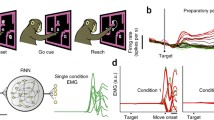Abstract
In this paper, we present a model for the development of connections between muscle afferents and motoneurones in the human spinal cord. The model consists of a limb with six muscles, one motoneurone pool, one pooled (Ia-like) afferent for each muscle and a central programme generator. The weights of the connections between the afferents and the motoneurone pools are adapted during centrally induced movements of the limb. The connections between the afferents and the motoneurone pools adapt in a hebbian way, using only local information present at the synapses. This neural network is tested in two examples of a limb with two degrees of freedom and six muscles. Despite the simplifications, the model predicts the pattern of autogenic and heterogenic monosynaptic reflexes quite realistically.
Similar content being viewed by others
References
Bizzi E, Hogan N, Mussa-Ivaldi FA, Giszter S (1992) Does the nervous system use equilibrium-point control to guide single and multiple joint movements? Behav Brain Sci 15:603–613
Cavallari P, Katz R (1989) Pattern of projections of group I afferents from forearm muscles to motoneurones supplying biceps and triceps muscles in man. Exp Brain Res 78:465–478
Denier van der Gon JJ, Coolen ACC, Erkelens CJ, Jonker HJJ (1990) Self-organizing neural mechanisms possibly responsible for muscle coordination. In Winters JM, Woo SL-Y (eds) Multiple muscle systems. Springer, Berlin Heidelberg New York, pp 335–342
Eccles JC, Eccles RM, Lundberg A (1957) The convergence of monosynaptic excitatory afferents onto many species of alpha-motoneurones. J Physiol (Lond) 349:519–534
Feldman AG (1986) Once more on the equilibrium-point hypothesis (λ-model) for motor control. J Motor Behav 18:17–54
Flash T, Mussa-Ivaldi F (1990) Human arm stiffness characteristics during the maintenance of posture. Exp Brain Res 82:315–326
Fritz N, Illert M, de la Motte S, Reeh P, Saggau P (1989) Pattern of monosynaptic Ia connections in the cat forelimb. J Physiol (Lond) 419:321–351
Gielen CCAM, Ramaekers L, van Zuylen EJ (1988) Long-latency stretch reflexes as co-ordinated functional responses in man. J Physiol (Lond) 407:275–292
Goossens HHLM, Smeets JBJ, Erkelens CJ (1993) Different relative activations of mono- and bi-articular muscles in two isometric force tasks. (submitted for publication)
Hebb DO (1949) The organization of behavior: a neuropsychological theory. Wiley, New York
Hogan N (1985) The mechanics of multi-joint posture and movement control. Biol Cybern 52:315–331
Jongen HAH (1989a) Coordination of muscles acting across the shoulder and elbow joint in isometric contractions: experimental results. In: Theories and experiments on muscle coordination during isometric contractions. Thesis, University of Utrecht
Jongen HAH (1989b) A theory on the coordination of muscles acting across the shoulder and elbow joint in isometric contractions. In: Theories and experiments on muscle coordination during isometric contractions. Thesis, University of Utrecht
Kalveram KT (1992) A neural network model rapidly learning gains and gating of reflexes necessary to adapt to an arm's dynamics. Biol Cybern 68:183–191
Lo Y-J, Poo M (1991) Activity-dependent synaptic competition in vitro: heterosynaptic suppression of developing synapses. Science 254:1019–1022
Loeb GE, He J, Levine WS (1989) Spinal cord circuits: are they mirrors of musculoskeletal mechanics? J Motor Behav 21:473–491
McCrea DA (1986) Spinal cord circuitry and motor reflexes. Exerc Sport Sci Rev 14:105–141
Miller LE, Gielen CCAM, Theeuwen M, Doorenbosch C (1992) The activation of mono- and biarticular muscles in multijoint movements. In: Camminiti R, Johnson PB, Burnod Y (eds) Control of arm movement in space. Springer, Berlin Heidelberg New York, pp 1–16
Nelson PG, Yu C, Fields RD (1989) Synaptic connections in vitro: modulation of number and efficacy by electrical activity. Science 244:585–587
Nelson PG, Yu C, Fields RD, Neale EA (1990) Mechanisms involved in activity-dependent synapse formation in mammalian central nervous system cell cultures. J Neurobiol 21:138–156
O'Sullivan MC, Eyre JA, Miller S (1991) Radiation of phasic stretch reflex in biceps brachii to muscles of the arm in man and its restriction during development. J Physiol 439:529–543
Prochazka A (1989) Sensorimotor gain control: a basic strategy of motor systems? Prog Neurobiol 33:281–307
Smeets JBJ (1991) A self-organizing neural network model for the development of muscle co-ordination. In: Co-ordination in reflex control of arm movements. Thesis, University of Utrecht
Smeets JBJ, Erkelens CJ (1991) Dependence of autogenic and heterogenic stretch reflexes on preload activity in the human arm. J Physiol 440:455–465
Smeets JBJ, Erkelens CJ, Denier van der Gon JJ (1990) Adjustments of fast goal-directed movements in response to an unexpected inertial load. Exp Brain Res 81:303–312
Tax AAM, Denier van der Gon JJ (1991) A model for neural control of gradation of muscle force. Biol Cybern 65:227–234
van Zuylen EJ, Gielen CCAM, Denier van der Gon JJ (1988) Coordination and inhomogeneous activation of human arm muscles during isometric torques. J Neurophysiol 60:1523–1548
Webb CB, Cope TC (1992) Modulation of Ia EPSP amplitude: the effects of chronic synaptic inactivity. J Neurosci 12:338–344
Winter DA (1979) Biomechanics of human movement. Wiley, New York
Wolpaw JR, Carp JS (1990) Memory traces in spinal cord. Trends Neurosci 13:137–142
Yamaguchi GT, Sawa AG-U, Moran DW, Fessler MJ, Winters JM (1990) A survey of human musculotendon actuator parameters. In: Winters JM, Woo SL-Y (eds) Multiple muscle systems. Springer, Berlin Heidelberg New York, pp 717–773
Zisper D (1992) Identification models of the nervous system. Neuroscience 47:853–862
Author information
Authors and Affiliations
Rights and permissions
About this article
Cite this article
Smeets, J.B.J., van der Gon, J.J.D. An unsupervised neural network model for the development of reflex co-ordination. Biol. Cybern. 70, 417–425 (1994). https://doi.org/10.1007/BF00203234
Received:
Accepted:
Issue Date:
DOI: https://doi.org/10.1007/BF00203234




